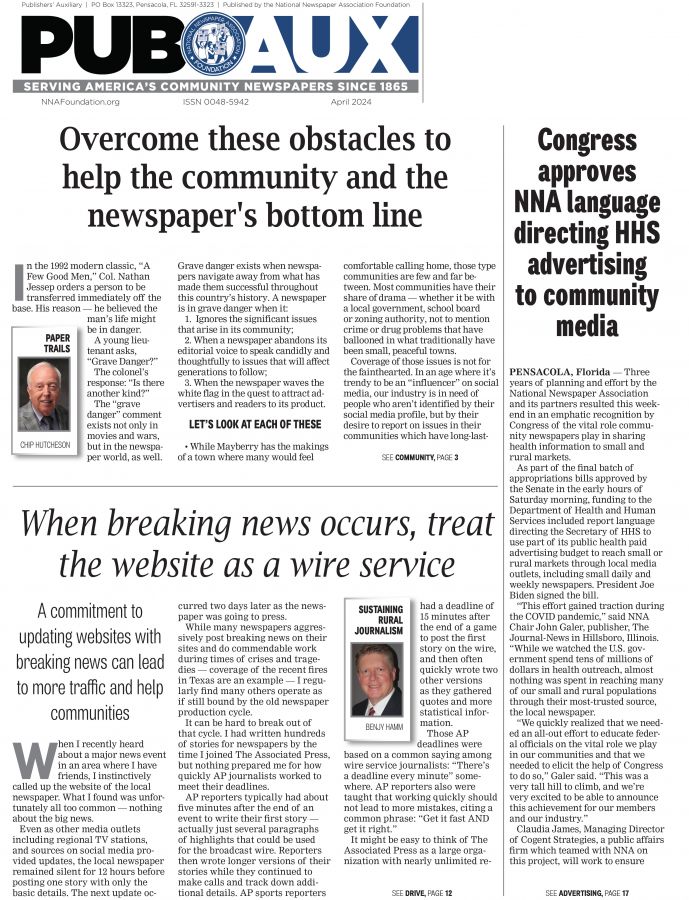Pew reading study points to good news for newspapers
Oct 27, 2016
By C. Dennis Schick
Special to Publishers’ Auxiliary
Recently, after I read a research study by the Pew Research Center, I almost ran out and bought a newspaper!
Really? Well, not exactly, but my newspaper-oriented mind surely felt good as I thought how I might respond if I was still working for a newspaper. Let me explain.
The Pew report is “Book Reading 2016” and just came out a few weeks ago. That title grabbed my attention mainly because I have been a life-long book (and newspaper) reader. The study was based on a nationally-representative phone survey of 1,520 American adults conducted between March 1 and April 4 of this year. I also was impressed that at least one evening newscast and the Public Broadcast Network reported the study.
So how does a research study about book reading relate to newspapers? First, here are some of the study highlights, followed by my applications and recommendations for newspaper people.
We all can agree with the report’s opening sentence: “Americans today have an enormous variety of content available to them at any time of day, and this material is available in a number of formats and through a range of digitally connected devices.” I would have added the word “wide” before “range.” Reading options are everywhere.
But even with all those reading options—as well as all the other demands on our time—the share of Americans who have read a book in the past 12 months (73 percent) has remained steady over the past four years. This is encouraging because some people have regularly predicted the death of reading and books (and newspapers). At least people are still reading.
And when asked if they read at least one print book within the past year, a whopping 65 percent said they had. That is more than twice as many as those who had read an e-book (28 percent), and more than four times the percentage whom said they listened to an audiobook (14 percent).
Although words on paper is still the preferred mode of reading books for most people, not surprisingly, words produced electronically have increased during the past five years, according to the study. For instance, e-book readership increased 11 percentage points between 2011 and 2014 (from 17 percent to 28 percent), but remained unchanged the past two years. The number of people who listen to audiobooks has also increased, but only a little during the past five years (11 percent to 14 percent).
More than a quarter (28 percent) of Americans read books in both print and digital formats (e-books and audio-books), but nearly four out of 10 (38 percent) read print books exclusively.
Regarding demographics, most of the study findings are not surprising. For instance, college graduates are more likely to read books in any format—including print—than non-graduates. College graduates also have more experience in reading on electronic devices of all sorts.
As for race, age and other demographic breakdowns, again there are no big surprises. We don’t have room here to get into specifics, but the study does give rather detailed information for anyone interested. Also, there are other aspects of the study that some people will find interesting.
So why should newspaper people care, and what does the study mean for us print-a-holics? First, the fact that people are still reading is good news. As the old International Paper advertising campaign said, “Send me a man who reads.” Reading is still fundamental to almost everything.
Secondly, reading books directly translates to reading newspapers. For many, many people, holding words on paper is still important to them. And yes, some people even like the feel and smell of paper and ink (even though some still complain about newspaper ink rubbing off on them).
Thirdly, reading gives many people pleasure and satisfaction in various ways. When asked why they read written content of any kind (including books, newspapers and magazines), 84 percent said to research specific topics of interest, 82 percent said to keep up with current events, 80 percent said for pleasure, and 57 percent said for work or school. Reading is important in their lives.
Fourthly, we should be thankful that many American adults are comfortable with reading words delivered electronically, because that means they are more likely to read any electronic content we provide to them. This also suggests that those who have been thinking about producing an electronic version for a long time, might move forward and do it.
Finally, the content of those words on paper seems to sink in better, makes more of an impression, and is remembered better than electronic words. Or at least that’s what many people say, so who am I to argue?
With my advertising (and reporting) background, I automatically think promotion. I want to use the information in this study for an article to inform readers, and for use in house ads. In both, I would congratulate the readers and advertisers for recognizing the vital role of reading books and newspapers in their lives and businesses, as well as in the community. And if I could, I would somehow work local libraries, reading programs, education, etc., into the discussion.
The bottom line is, there is good, meaningful information out there. Seek it out and use it to your best advantage. Toot your own horn. Promote what you do better than anyone else. For the complete readership study, go to pewinternet.org/2016/09/01/book-reading-2016. While you’re there, look around. There are other articles of interest, too. (See more stories on promotion in the special section starting on Page 6.) © Dennis Schick 2016
Dennis Schick retired in 2004 after 25 years as executive director of the Arkansas Press Association. He is still an active journalist, writer and newspaper reader and observer. He lives in North Little Rock, AR.







